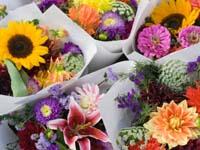 There’s nothing like fresh flowers to inject positive energy into a room, and there’s no reason to wait for someone to send you buy some — I buy myself fresh ones every week! It’s a great way to treat yourself, while keeping your home cheerful and smelling nice at a relatively low cost. With some research and a little help from A-list celebrity florist Brent Wang (www.eggslosangeles.com), I compiled the following tips to help maximize the life of your fresh flowers and get the most out of your arrangements.
There’s nothing like fresh flowers to inject positive energy into a room, and there’s no reason to wait for someone to send you buy some — I buy myself fresh ones every week! It’s a great way to treat yourself, while keeping your home cheerful and smelling nice at a relatively low cost. With some research and a little help from A-list celebrity florist Brent Wang (www.eggslosangeles.com), I compiled the following tips to help maximize the life of your fresh flowers and get the most out of your arrangements.
Choose the Bunch
First of all, buy flowers that are still in bud. You will be able to enjoy watching them open, and they will have a longer vase life than those purchased in full bloom. As soon as you get those babies home, remove all the leaves on the stem that will fall below the water line. The excess foliage encourages bacteria growth in the vase, requiring more energy from the flowers to stay alive.
Home Vase
Next, cut off about one inch from the bottoms of the stems and immediately plunge them into a container or vase filled with lukewarm water. It’s important to use lukewarm water because it’s more easily absorbed, except for with cold weather blooms, such as tulips, which thrive in cold water. Always use clean vases or containers to prevent any bacteria from ruining the quality of the flowers. Bulb flowers such as daffodils, jonquils and narcissus should be placed in shallow water; deep water causes their thick stems to become waterlogged and quickly shrivel up.
Stems should be cut at a 45-degree angle for best water absorption. Use garden shears or a sharp knife, as regular household scissors can crush the vascular systems of the flower stem and inhibit water uptake.
Some flowers require a great deal of special treatment. “Flowers with woody stems, such as lilacs, viburnum, hydrangea, rhododendrons, and blooming branches like quince and cherry blossoms do not take up water readily,” Brent said. “For these types, it’s best to crush the stems with a hammer or a mallet and then split them to help with water uptake.” The stems of bulb flowers should be snipped across at an angle, and the sticky white secretion should be washed away to lengthen their life.
Many myths exist as to what to put in the water for longer lasting flowers. Brent’s favorite concoction is a tablespoon of lemon lime soda (some sort of “uncola” like Sprite or 7-Up; it must be without caffeine) with a few drops to bleach, per liter of water. Note: diet soda won’t work – it is the sugar in regular soda that helps maintain your bouquet’s shelf life.
The Arrangement
Avoid overcrowding in the vase — make sure there is enough space for air to circulate between each flower. Too many flowers crowded together may cause the petals to get squashed and bruised.
As the flowers in an arrangement start to fade away, gather any blooms that still look good and arrange them in a smaller vase. Roses can be revived by gently pulling off exterior petals that look browned and crumpled.
“The most important thing you can do to prolong the life of your flowers is to cut the stems every other day, if possible, and change the water as often as you can,” Brent suggested. “Also, it’s best to spritz them with water, just enough so they look like they have a fresh morning dew, before placing them back in the container.”
Do not place flowers near a heater, on top of a television set or in direct sunlight. The heat will cause excess water loss from the flowers, and they will wilt very quickly. It is best to place your flowers is in a cool room, yet you should keep them away from fans.
For more information and amazing one-of-a-kind floral arrangements, visit Brent’s Web site at www.eggslosangeles.com.
Chaton Anderson is a Writer and the Publicity Director for TheSavvyGal.com. A product and pop culture addict, she is always looking for the coolest, hippest things on the market, as well as the newest health and fitness trends to hit the scene. Email her at Chaton@TheSavvyGal.com with questions or leads on products and services on the cutting edge.
